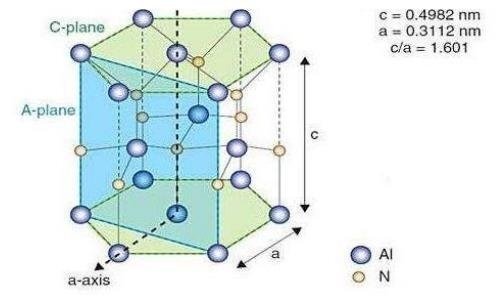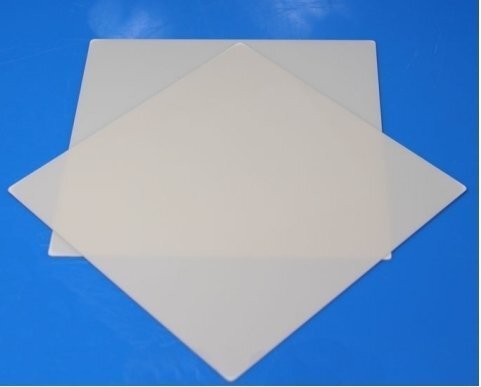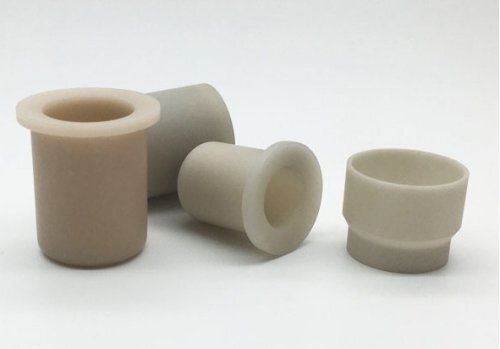Aluminum nitride is a typical third-generation semiconductor material. It has an extremely wide band gap and very large exciton binding energy, of which the band gap width is 6.2 eV, which belongs to a direct band gap semiconductor. As aluminum nitride has a variety of outstanding physical properties, such as high breakdown field strength, thermal conductivity, resistivity, etc., it has always been concerned in the semiconductor field, and is also a material that has been “conquered” in the semiconductor field.
Performance characteristics of aluminum nitride
ALN is a crystal dominated by covalent bonds and belongs to hexagonal diamond-like nitride. Its theoretical density is 3.26g/cm3, and its Mohs hardness is 7~8. It has high strength at room temperature, and its strength will decline slowly with the increase of temperature.

Compared with several other ceramic materials, aluminum nitride has excellent comprehensive properties, especially its excellent thermal conductivity, which is very suitable for semiconductor substrates and structural packaging materials, and has great application potential in the electronic industry.
Application of aluminum nitride in semiconductor field:
1. Ceramic packaging substrate
Ceramic packaging substrate With the vigorous development of microelectronics and semiconductor technology, motors and electronic components step into the era of miniaturization, lightweight, high energy density and high power output. The heat flow density of electronic substrate has increased significantly, and maintaining a stable operating environment inside the equipment has become a technical problem that needs to be focused on. ALN ceramic is considered as an ideal material for new generation heat dissipation substrate and electronic device packaging because of its high thermal conductivity, thermal expansion coefficient close to silicon, high mechanical strength, good chemical stability, environmental protection and non-toxic characteristics.

Compared with Al2O3 ceramic substrate and Si3N4 ceramic substrate, ALN ceramic substrate has these advantages: using ALN ceramic substrate as the carrier of the chip can isolate the chip from the module heat dissipation backplane, the ALN ceramic layer in the middle of the substrate can effectively improve the insulation capacity of the module (ceramic layer insulation withstand voltage>2.5KV), and aluminum nitride ceramic substrate has good thermal conductivity, and the thermal conductivity can reach 170-260W/mK. In addition, the expansion coefficient of ALN ceramic substrate is similar to that of silicon, which will not cause stress damage to the chip. The peel resistance of aluminum nitride ceramic substrate is>20N/mm2, which has excellent mechanical properties, corrosion resistance, is not easy to deform, and can be used in a wide temperature range.
2. Semiconductor equipment components
The semiconductor equipment parts are very important for the heat dissipation of the silicon wafer in the semiconductor processing. If the uniform temperature of the silicon wafer surface cannot be guaranteed, the uniformity of the processing will not be ensured during the processing of the silicon wafer, and the processing accuracy will also be affected.

The advantages of using aluminum nitride as the main material for the aluminum nitride electrostatic chuck are that: a wide range of temperature range and sufficient adsorption force can be obtained by controlling its volume resistivity, and the electrostatic chuck can achieve good temperature uniformity through the high degree of freedom heater design; The aluminum nitride is formed through integrated co firing, which will not cause lasting changes due to electrode degradation, and will ensure the product quality to the maximum extent; Lasting operation in plasma halogen vacuum atmosphere to withstand the most demanding process environment of semiconductor and microelectronics, it can also provide stable adsorption and temperature control.
3. High temperature structural materials
Aluminum nitride ceramics have good corrosion resistance, stability and insulation at room temperature and high temperature. It will decompose at 2450 ℃. It can be used as high-temperature refractory materials, such as crucibles and casting molds. Aluminum nitride ceramics can not be wetted by copper, aluminum, silver and other substances, and can resist the corrosion of aluminum, iron, and aluminum alloys. It can become a good container and high-temperature protective layer, such as thermocouple protective tubes and sintering appliances; It can also resist the erosion of high-temperature corrosive gas, and is used to prepare aluminum nitride ceramic electrostatic chuck, which is an important high-end component of semiconductor manufacturing equipment. As aluminum nitride is stable to molten salts such as gallium arsenide, such as aluminum nitride crucibles, thermocouple protection tubes and sintering appliances, it can also be used as containers and processors for corrosive substances instead of glass to synthesize gallium arsenide semiconductors, which can eliminate silicon pollution from glass and obtain high-purity gallium arsenide semiconductors. The aluminum nitride is very stable under the non oxidizing atmosphere until 2000 ℃, so it can be used as the aggregate of refractories used under the non oxidizing atmosphere.

